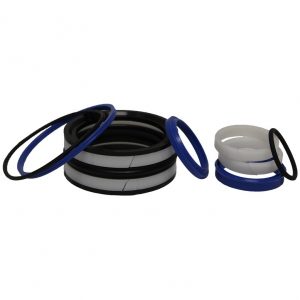Hydraulic Cylinder Components
A hydraulic cylinder is made up of the following components
Cylinder Cap
The cylinder cap keeps pressure from going out of the chamber during piston reciprocal movements by enclosing the cylinder at one end. Caps also function as parts for cylinder mounting. The parts are cap clevis, cap flange, and cap trunnion. The cap can be welded to the body, threaded, bolted, or connected via a tie rod. Its size is determined based on the bending stress. If it is not joined to the cylinder by welding, a seal ring is placed in between the cap and barrel.

Hydraulic Cylinder barrel
The cylinder barrel is seamless to ensure pressure stays within the chamber. The inner chamber of the barrel is ground to a very fine surface finish of 4-16 micro inch to allow free movement of piston as it reciprocates or makes its upward and downwards movement in the chamber.
Cylinder barrel
Cylinder head
The cylinder head is attached to the body through threading, bolts, or ties rod, and a static seal is used in between head and barrel. It encloses pressure from the other end of the chamber with an integrated rod sealing set- up or if acceptable, a seal gland.
Cylinder head
Piston
The piston is attached to the piston rod through bolts, nuts, and threads which enables the transfer of linear motion. The piston also contains grooves where elastomeric rings- single acting and double acting -can fit in. the piston has a core function of separating the two sides of pressure in the barrel. The cylinder extends and contracts with the reciprocating motion of the cylinder.
Hydraulic Piston
Piston rod
The piston rod is the connector between the hydraulic actuator parts and the machine component doing the work through a machine thread or mounting attachment. It is basically a hard chrome-plated piece of cold-rolled steel that is attached to the piston, extending from the cylinder to the rod-end head. The actuator of a double rod end cylinder has a rod extending from both sides of the piston and out both ends of the barrel.
Hydraulic Piston Rod
Seal gland
The seal gland is made up of a primary seal, a secondary seal, bearing elements, wiper, and static seals. In the area of the seal gland, seals are placed in the cylinder head to prevent oil under pressure from leaking past the interface between the rod and the head. Sometimes, especially in small hydraulic cylinders, the rod gland and the bearing elements are made from a single integral machined part.
hydraulic Cylinder Seal gland
Seals
 Various conditions determine the kind of seal to be used. These hydraulic cylinder seals include speed, operating temperature, working medium, application, and cylindrical working pressure. Piston seals can be single acting or double acting and they are dynamic. They are elastomeric in composition and made from nitrile rubber, polyurethane, or other materials. Seals made of these materials work better in lower temperature environments while seals made from fluorocarbon Viton are fit for higher temperatures. Metallic seals are made up of cast iron and are readily available. Rod seals are single-acting and made up of nitrile rubber polyurethane or fluorocarbon Viton. Wipers remove contaminants like moisture, dirt, and dust which can cause damages to cylinder walls rods, seals, and other components. The common compound for wipers is polyurethane. Sub-zero applications and applications where foreign materials can be deposited require metallic scrapers. . Wear bands -made of filled PTFE and woven fabric reinforced polyester resin and bronze- are designed based on load requirements.
Various conditions determine the kind of seal to be used. These hydraulic cylinder seals include speed, operating temperature, working medium, application, and cylindrical working pressure. Piston seals can be single acting or double acting and they are dynamic. They are elastomeric in composition and made from nitrile rubber, polyurethane, or other materials. Seals made of these materials work better in lower temperature environments while seals made from fluorocarbon Viton are fit for higher temperatures. Metallic seals are made up of cast iron and are readily available. Rod seals are single-acting and made up of nitrile rubber polyurethane or fluorocarbon Viton. Wipers remove contaminants like moisture, dirt, and dust which can cause damages to cylinder walls rods, seals, and other components. The common compound for wipers is polyurethane. Sub-zero applications and applications where foreign materials can be deposited require metallic scrapers. . Wear bands -made of filled PTFE and woven fabric reinforced polyester resin and bronze- are designed based on load requirements.
Other parts of the hydraulic cylinder
Other components make up the internal portion of a hydraulic cylinder. All of these parts combine to make a fully functional component.
- Cylinder base connection
- Cushions
- Internal Threaded Ductile Heads
- Head Glands
- Polypak Pistons
- Cylinder Head Caps
- Butt Plates
- Eye Brackets/Clevis Brackets
Image Source: Amazon.com






